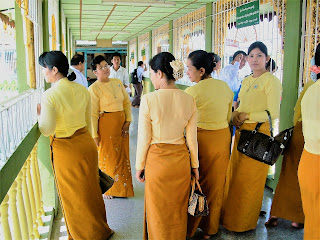Sari-Sarong - 2
 The sarong with a tightly fitted blouse used to be the everyday outfit all over South-East Asia. Now, it has given way either to Western fashion like in Thailand or to Islamic attire like in Malaysia and Indonesia. The sarong and blouse or kebaya (see post Betty's Kebaya, June 24) is often reserved for ceremonial events or for women working in the tourist sector. Only the Buddhist country Myanmar and Bali, the Indonesian Buddhist province, are holding on to the tradition of beautiful sarongs. You just have to look at Myanmar’s political icon Aung San Suu Kyi and you can see how becoming this uniform is.
The sarong with a tightly fitted blouse used to be the everyday outfit all over South-East Asia. Now, it has given way either to Western fashion like in Thailand or to Islamic attire like in Malaysia and Indonesia. The sarong and blouse or kebaya (see post Betty's Kebaya, June 24) is often reserved for ceremonial events or for women working in the tourist sector. Only the Buddhist country Myanmar and Bali, the Indonesian Buddhist province, are holding on to the tradition of beautiful sarongs. You just have to look at Myanmar’s political icon Aung San Suu Kyi and you can see how becoming this uniform is. 

Have you ever tried to row a boat while standing on one leg only? The fishermen on the Inle Lake in Northern Myanmar are performing this acrobatic act every day. I took a boat on this beautiful lake to visit the Khit Sunn Yin Lotus Weaving Centre perched on stilts over the waters. The Lotus weavers still practice hand weaving for traditional sarongs.
 Mine is made of cotton and
silk and has ribbons to keep the sarong in place more easily. My favourite
sarongs are communicating with one another although they do not speak the same
language. The Barefoot company
in Colombo founded by legendary artist and designer Barbara Sansoni where I
bought the dark green piece swears by the tunnel shaped sarong.
Mine is made of cotton and
silk and has ribbons to keep the sarong in place more easily. My favourite
sarongs are communicating with one another although they do not speak the same
language. The Barefoot company
in Colombo founded by legendary artist and designer Barbara Sansoni where I
bought the dark green piece swears by the tunnel shaped sarong.I am still learning to fasten it so tightly that it does not fall down. Even the local people seem to have the same difficulties. You can see many men in Myanmar tucking up their sarongs every now and then. Yes, the sarong is a man’s dress in Myanmar as is the doti in more traditional milieus of India.






Comments
Post a Comment